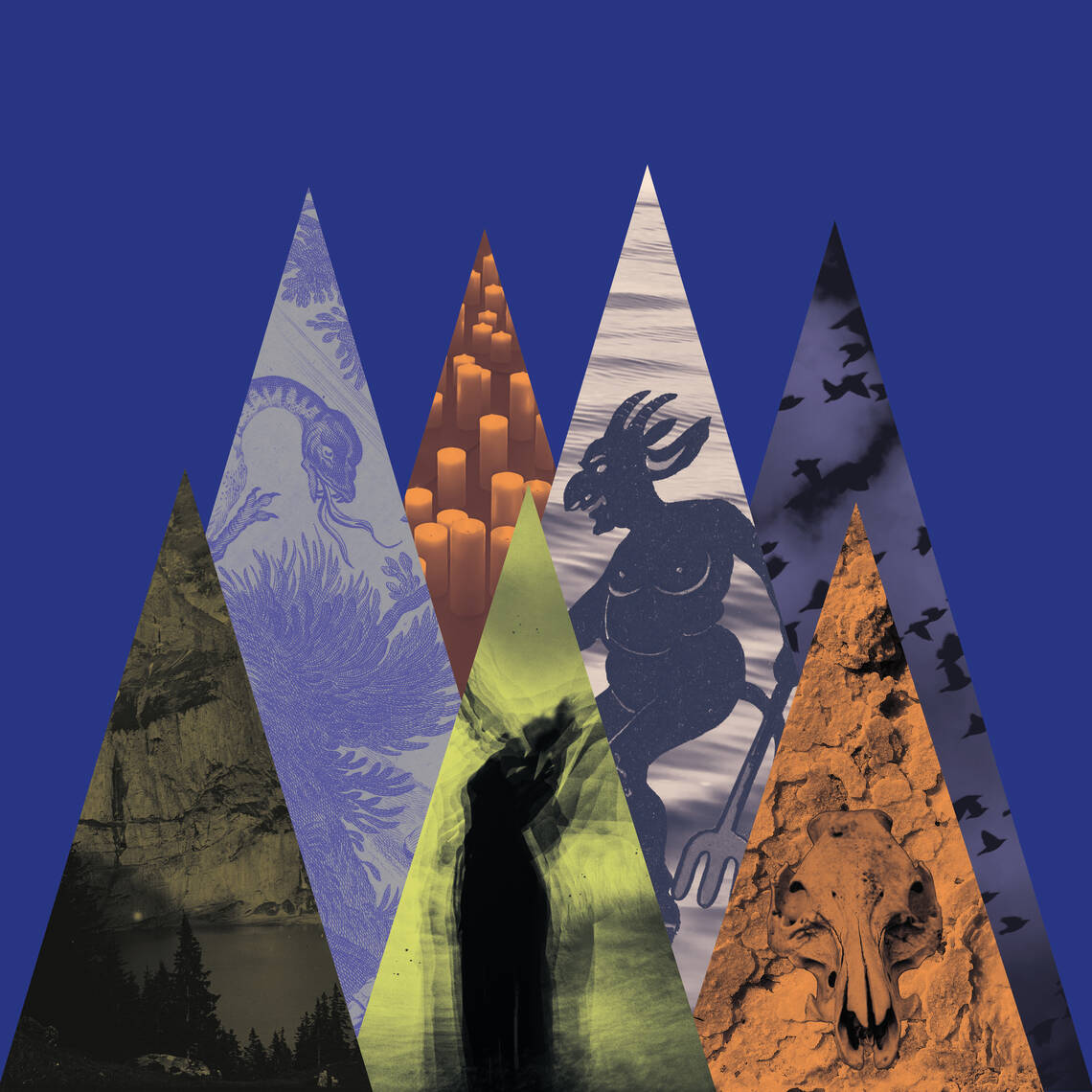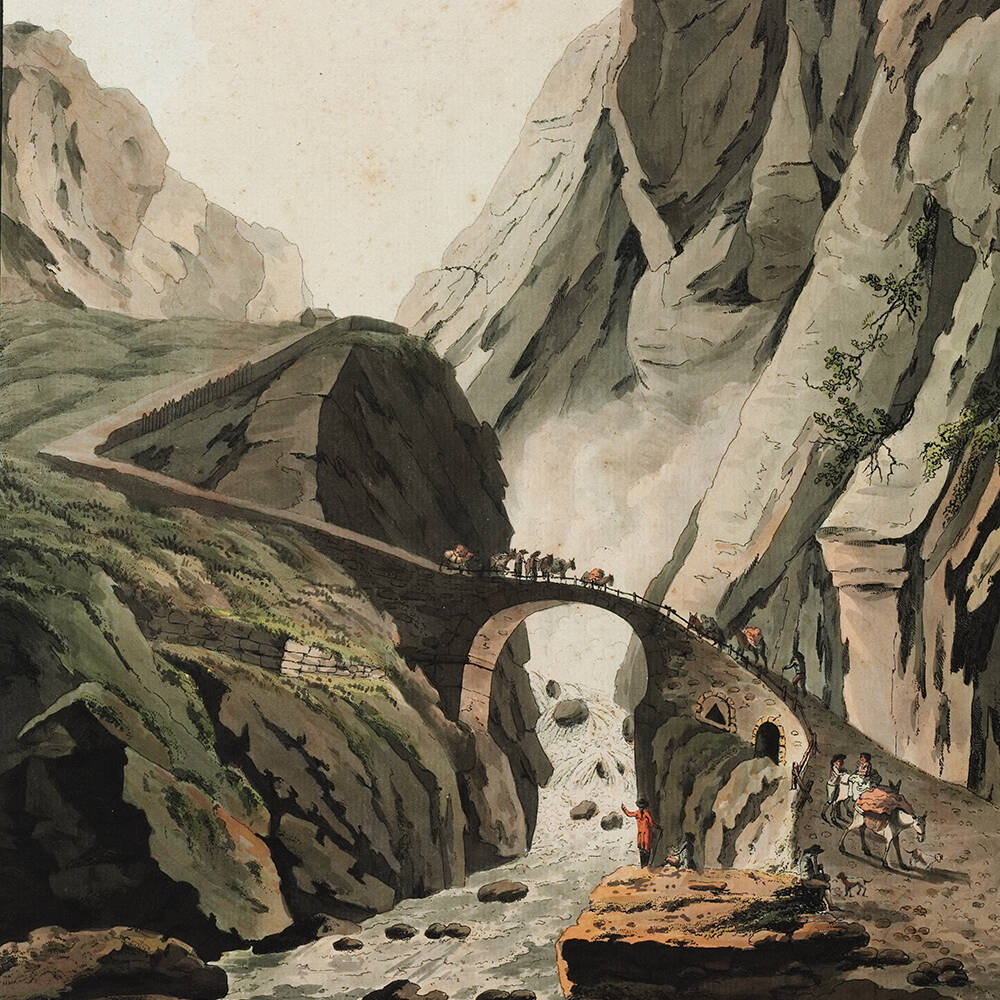accessibility.sr-only.body-term
When dolls come to life, fertile pastures transform into rocky deserts or a woman assumes an animal form, we’ve truly entered the land of myths and legends. Demonic legends tell of supernatural, eerie happenings revolving around ghosts, witches, dragons and even the devil. Historical myths speak of factual or alleged figures from the past. A legend is always linked to a real place – the tale gains credibility that way. Whether it’s Sennentuntschi, the Devil’s Bridge, or the tale of Blüemlisalp, the Swiss Alps are rich with legends which are just waiting to be retold and passed on…

Traditional tales from the Alps
Guided tour for private groups
Guided tour of the exhibition "Traditional tales from the Alps".
Tour: 1 hour
Guided tours can be arranged outside opening hours: Mon between 9.30 am and 6 pm, Tue to Fri between 9.30 am and 7.45 pm. Sat and Sun between 10 am and 5 pm
| Registration: |
2 weeks in advance |
|
|
Duration: |
60 minutes; special packages can be offered on request |
|
|
Group size: |
max. 25 participants per tour |
|
|
Languages: |
English, German, Italian, French. Other offers upon request. |
|
|
Cost: |
CHF 180 for the guided tour + CHF 10 admission per person Children up to 16 years free. For groups of persons with permit N, S, F, the guided tour and admission are free of charge. |
accessibility.sr-only.person_card_info Reservations desk
Monday till Friday 09:00 - 12:30

Traditional tales from the Alps – Introductory tour
Intermediate level | secondary levels I and II
Legends have been part of the cultural heritage of Switzerland for centuries. Which characters populate these legends? How to the tales explain mysterious natural phenomena? The exhibition will enable students to discover the crossbow said to have belonged to William Tell and other objects steeped in legend.
1 hour
Guided tours are free of charge for school classes from Switzerland.
Teachers are advised that their students may react emotionally to, or be disturbed by, certain objects on display in the exhibition.
Guided tours in English can be arranged, even outside opening hours. Guided tours are free of charge for school classes from Switzerland.
| Booking: |
at least 2 weeks in advance |
|
|
Duration: |
1 hour guided tours, other services by prior arrangement |
|
|
Group size: |
max. 25 people |
|
|
Cost: |
Guided tours for school classes from Switzerland are free of charge. |
accessibility.sr-only.person_card_info Reservations desk
Monday till Friday 09:00 - 12:30

Traditional tales from the Alps – magical creatures and real places
Kindergarten | Elementary school
There’s something a little spooky about hearing an old legend. Which magical beings are we going to face? Where in the mountains are the legends set? During their tour of the exhibition, the children will encounter exciting characters, will hear an old legend, and will be immersed in an eerily beautiful world.
1 hour
Guided tours are free of charge for school classes from Switzerland.
Teachers are advised that their students may react emotionally to, or be disturbed by, certain objects on display in the exhibition.
Guided tours in English can be arranged, even outside opening hours. Guided tours are free of charge for school classes from Switzerland.
| Booking: |
at least 2 weeks in advance |
|
|
Duration: |
1 hour guided tours, other services by prior arrangement |
|
|
Group size: |
max. 25 people |
|
|
Cost: |
Guided tours for school classes from Switzerland are free of charge. |
accessibility.sr-only.person_card_info Reservations desk
Monday till Friday 09:00 - 12:30
Traditional tales from the Alps
Whether it’s the tale of the Blüemlisalp, William Tell or the Devil’s Bridge, the Swiss Alps are steeped in legends. At the National Museum Zurich, some of these stories are being told right now.
When dolls come to life, fertile pastures transform into stony deserts or a woman takes on animal form, we’ve truly entered the realm of legends and folk tales. Unlike fairy tales, this type of story can have a veneer of credibility because legends are always connected to real places. Historical legends in particular can appear to have a ring of “truth”. Reputed or actual figures from history are placed in real locations. One of the most famous examples is Tell’s shooting of the apple. The story, which first appeared in Nordic mythology, fitted perfectly with the realities of life in Central Switzerland and as time went by it evolved into an important liberation myth. William Tell was a hero whose story offers a plethora of different angles: his message could be related to rebelling against authority figures, it could highlight the necessity of having one’s own independence, or it might reinforce the courage to resist. Tell was later stylised as a national hero, and his crossbow has become a seal of quality for products from Switzerland.
The first person to set down the story of William Tell in writing was Hans Schriber. The Obwalden county scribe immortalised the legendary hero in the White Book of Sarnen in 1470. Another famous legend was put on paper about 250 years later. In 1707, physician and natural scientist Johann Jakob Scheuchzer published the legend of the Blüemlisalp. A vain and wasteful herdsman lives in plenty on his fertile alp, while the people in the valley below are starving. But he refuses to share his abundance, and even derides the despairing valley dwellers. As a punishment, the thriving alp transforms into a wasteland of rocks and ice. The legend can be found throughout the Alpine region in a number of different variations, and Scheuchzer was quick to recognise its instructional function.
Regardless of how much truth they contain, legends still exert a powerful influence today. And when the shadows lengthen and suddenly take on the shape of the devil, or a mountain stream thunders down a ravine, growling and raging like a dragon, it’s easy to understand why these phenomena used to strike fear into people’s hearts.
Documents
Images
National Museum Zurich press contact
- OVERALL MANAGEMENT Denise Tonella
- CURATORS AND CONCEPT Pia Schubiger, Daniela Schwab
- PROJECT DIRECTION Daniela Schwab
- SCENOGRAPHY Martina Nievergelt, Zürich; Ralph Nicotera Szenografie und Innenarchitektur, Männedorf
- SCIENTIFIC ADVISORS Peter Egloff
- PROJECT ASSISTANT Noemi Albert
- ADVISORY COMMITTEE Heidi Amrein, Beat Högger, Markus Leuthard, Sabrina Médioni, Denise Tonella
- CONTROLLING OF PROJECT Sabrina Médioni
- CULTURAL SERVICES AND MUSEUM EDUCATION Gerda Bissig, Lisa Engi, Vera Humbel
- ADVERTISING GRAPHIC Manu Beffa, Zürich
- EXHIBITION GRAPHIC Clavadetscher Gestaltung für Kultur und Wirtschaft, Schwyz
- TECHNICAL MANAGEMENT Henrike Binder
- EXHIBITION CONSTRUCTION Bachir Ezzerari, Ladina Fait, Marc Hägeli, Philippe Leuthardt, Sophie Lühr, David Schwitter
- CONSERVATION MANAGEMENT Alexandra Schorpp
- CONSERVATION AND MONTAGE OF OBJECTS Natalie Ellwanger, Anna Jurt, Jürg Mathys, Ulrike Rothenhäusler, Alexandra Schorpp, Tino Zagermann
- LENDING AND LOGISTICS OF OBJECTS Christian Affentranger, David Blazquez, Simon D’Hollosy, Reto Hegetschweiler, Laura Mosimann, Markus Scherer, Samira Tanner, Angela Zeier
- PHOTOGRAPHY Jörg Brandt
- PICTURE LIBRARY Andrea Kunz, Fabian Müller
- IT | WEB Pasquale Pollastro, Thomas Bucher, Danilo Rüttimann, René Vogel
- MEDIA STATIONS Thomas Bucher, Pasquale Pollastro, René Vogel; Tweaklab AG, Basel
- ANIMATION AND SOUND INSTALLATION Movl GmbH Charlotte Germann; Tweaklab AG, Basel
- MARKETING AND COMMUNICATION Andrej Abplanalp, Anna-Britta Maag, Sebastiano Mereu, Carole Neuenschwander, Alexander Rechsteiner
- TRANSLATIONS Marie-Claude Buch-Chalayer, Peter Egloff, Gabriela Holderegger, Laurence Neuffer, Giovanna Planzi, Nigel Stephenson
- Gotthelf Zentrum Lützelflüh
- Hans Jörg Leu, Baden
- Historisches Museum Obwalden, Sarnen
- Kloster Disentis, Disentis / Mustér
- Monsieur Pierre-Yves Tribolet, Le Mont Pélérin
- Museum der Kulturen, Basel
- Museum Schloss Thun
- Museum Sursilvan, Trun
- Rätisches Museum, Chur
- Region Viamala, Thusis
- Staatsarchiv Graubünden, Chur
- Staatsarchiv Uri, Altdorf
- Tell-Museum, Bürglen
- Universitätsbibliothek Basel
- Verkehrshaus der Schweiz, Luzern
- Zentralbibliothek Zürich

